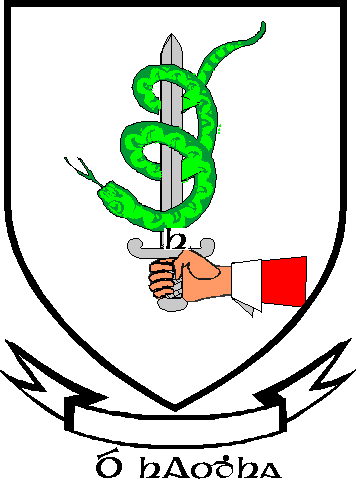|
O'Hea is one of the anglicized forms of the very common Gaelic surname Ó'hAodha, which has at least a dozen different and distinct origins in Ireland and is usually anglicized Hayes, except in Ulster where it has become Hughes. Ó'hAodha simply means descendant of Aodh, anglice Hugh. The sept so named, which is located in Corca Laoidhe - I.e. the south-western part of Co. Cork - is the only one which is called O'Hea in English and this form is invariable in that area. Murrough O'Hea was Bishop of Cork in 1205, and Maurice O'Hea was Bishop of Ross in 1559. In Co.. Cork only is the name found in directories to-day (apart from a few migrants to Dublin). John Fergus O'Hea (1850-1912), artist and cartoonist, was a Cork man, and Captain William O'Hea, an officer in Nicholas Browne's infantry in King James the Second's army, was of Aghamilly Castle in Pobble O'Hea, a district retained by the sept under the overlordship of the Barrys. |
 |
|
This name, by the way, was also known as Heas which is identical in pronunciation with Hayes. Hayes is a very common name in England. The name Hay (I.e Norman de la Haye) is on record in Co. Wexford since 1182. It has now become Hayes in most places. Irish Hayes are almost invariably scions of one of the Ó'hAodha septs. The most considerable of these was the Dalcassian sept of Thomond, now chiefly associated with Counties Limerick and Tipperary, whence came Catherine Hayes (1825-1861), singer, and the two painters Edward Hayes (1797-1864) and Michael Angelo Hayes (1820-1887). In the seventeenth century the form O'Hea, not Hayes, was used in Co. Clare as is evidenced by the number of O'Heas in Petty's census of 1659. Woulfe gives no less than twelve distinct septs of Ó'hAodha, including, as well as those mentioned above, others located around Ardstraw (Co. Tyrone), Ballyshannon (Co.. Donegal), Farney (Co. Monaghan), Navan (Co. Meath), Gorey (Co. Wexford), Ballintobber and Templemurray (Co. Mayo), Dromard (Co. Sligo) and one of the Ui Maine. |
|
